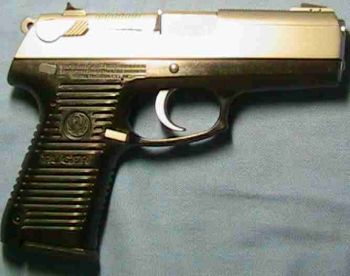
*The Ruger P97DC*
In 1997 Ruger set out to develop a 45ACP pistol built on a polymer frame. They had just achieved great success with the then new P95 9mm autopistol. This was the companyís first polymer framed autoloader. When the Ruger engineers set out on this task they did so in typical Ruger fashion. They overbuilt the pistol to achieve maximum durability. In fact they build the pistol to be able to handle the high pressures of the 10mm cartridge, although to this date Ruger has not produced a 10mm autopistol. Additionally, in typical Ruger fashion they designed their pistol such that it wouldnít win any beauty contests.

Sadly as of this year this pistol has been discontinued by Ruger and replaced with the current P345. A more svelt and ergonomic version of the P97 with a magazine disconnect safety, and a loaded chamber indicator (which the P97 does not have, thankfully). However the good news is the P97 can still be had on the used market for not too much dough. Buy with confidence because itís near impossible to wear one of these things out. You may have to replace small things here and there like a new mainspring, magazine spring, or new extractor, but a call to Rugerís excellent customer service will get you set up.
Field stripping the P97 is quite easy. It comes apart much like all of Rugerís other autopistols.
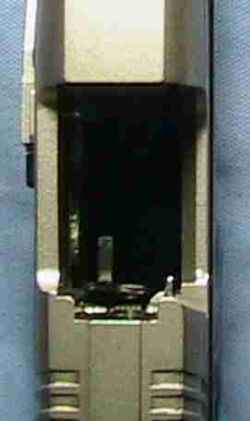
First, unload the weapon. If you donít know how you should seek professional help proto. Next, double check to make sure the weapon is unloaded, with magazine removed and nothing in the chamber. Now, lock back the slide. You will see the little black ejector through the ejection port. Pivot this ejector downward toward the magazine well. Make sure the slide is locked open firmly. You donít want to push the ejector down and for some reason have the slide slam shut on your finger.
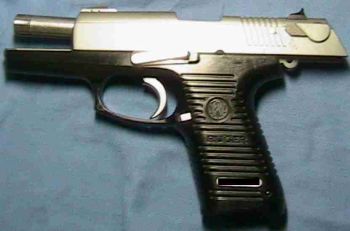
Now that you have the slide locked back, and the ejector pivoted downward, you are ready to remove the slide stop. This piece locks the slide to the frame. You will note on the left side of the frame and the left side of the slide there are two small lines. These lines are alignment marks. Release the slide stop, and move the slide alignment mark to the frame alignment mark. While you are holding the slide in the position, push the slide stop out from right to left.
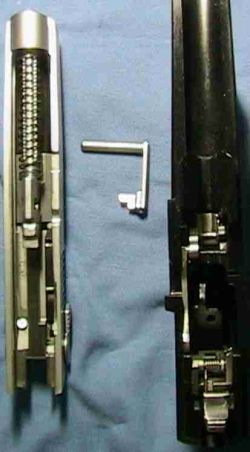
Remove the slide from the frame by pulling it forward off the frame. You will now have the slide assembly, frame, and slide stop disassembled.
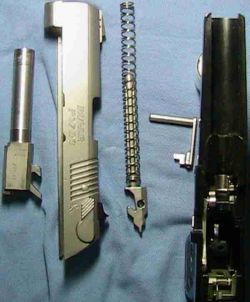
You may now remove what Ruger calls the camblock. Itís the rodlike piece of metal the spring rides on. Be careful, the spring and camblock are under spring tension and can go flying off. Once the spring and camblock are removed the barrel can be removed from the slide. This is the extent that Ruger recommends field stripping for cleaning. If youíre like me though youíll want to occasionally strip the slide down further to clean the firing pin, and firing pin channel.
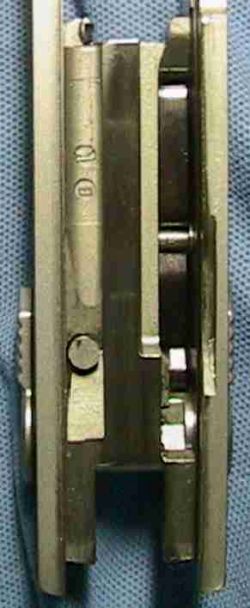
To do this for a decocking model only (the safety models are different, and Iím not sure how they work), you must first removed the extractor. To do this carefully grasp the extractor hook and pivot it outward 1 or 2mm. While pivoting it outward pull the extractor toward the front of the slide. This will remove the extractor and allow the decocker on the right side of the slide (looking from top of slide) to be removed. Next, you will notice the black leaf spring on the underside of the slide. You must depress this black leaf spring while removing the pin that holds the leaf spring in place. This can be tricky as the black leaf spring is under a lot of tension. Be, careful and take your time and youíll manage. Once the pin is removed the leaf spring will come out allowing the left side decocker lever to be removed. Now you can push the round firing pin safety located on the underside of the slide and remove the firing pin out the back. Be careful as the firing pin is under spring tension. You donít want to loose it. Assembly is the reverse of this procedure.
To reassemble the P97 for field stripping reverse the above procedure with one exception. When youíre placing the slide stop lever back in, do so partially while then gun is in fully battery, then slide the slide back until the alignment marks on the slide and frame match up, then fully insert the slide stop lever.
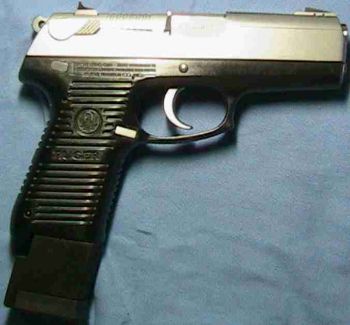
Above is a picture of the P97 with an aftermarket 10round Promag. Many people say these donít work well, but Iíve never had a problem with it. It may look a little ugly, but itís a great backup magazine and has never failed me. Some people have had good luck replacing the followers in aftermarket magazines with the genuine Ruger magazine follower. They can be ordered direct from Ruger for not much money.
Overall Iíve been very pleased with the P97. Itís been very reliable, and quite accurate. Like any mechanical device it does have its weaknesses. Let me give you a heads up on a couple of them.
There have been a few models of P97ís that have a tendency to loose their slide stops during firing causing the gun to disassemble. Ruger analyzed this problem and determined that some guns made it out the door with incorrect geometry on the camblock. No need to worry though. If during your testing of this model (and youíd better be testing your gear) give a call to Ruger. Theyíll send you out a new redesigned camblock and slide stop lever free of charge.
Two other weaknesses of this gun I can see are the extractor and slide stop. The extractor is a leaf spring extractor, much like on a 1911. Over time these can loose their spring and cause erratic extraction. Although, if youíre careful, you can re-bend it to return itís proper spring, much like tuning an extractor on a 1911. The better designed extractors in my opinion are the lever and spring type, much like on a Beretta, Glock, or Sig. The other weakness is the slide stop. The slide stop does not have a spring on it, much like a 1911. This hasnít caused me any problems, however I do prefer the designs where when the slide is lock and pressure is removed from the slide stop lever, the lever will automatically spring down. On the P97 and 1911 you need to be sure to rack the slide all the way to the rear to cause the slide stop to cam downward and release the slide. Not a big deal, I just prefer the other design.
The strengths of this gun are itís built like a tank. Itíd be pretty tough to break one of these things. Itís overbuilt so I expect a very long service life. Probably on the order of 100,000 rounds if you keep it maintained. The gun is also fairly slim, but not quite as slim as a 1911. It is thinner than Rugerís double stack 9mm line, however it is taller. The gun has proven very reliable for me. I would and do trust my life to it. Another benefit, is itís made right here in the good olí US of A. And to top that all off, you get Rugerís outstanding customer service to boot. The gun is also very affordable. Expect to pay less than $300 for one on the used market. Try to find a modern, reliable, durable 45 auto for that price point. Itís pretty tough to do.
Overall I highly recommend this pistol, pick one up if you get the chance.
Gogetemnow
www.alpharubicon.com
All materials at this site not otherwise credited are Copyright © 1996 - 2005 Trip Williams. All rights reserved. May be reproduced for personal use only. Use of any material contained herein is subject to stated terms or written permission.